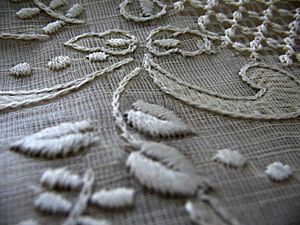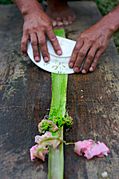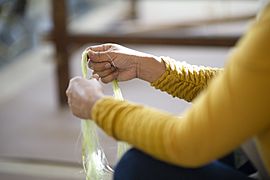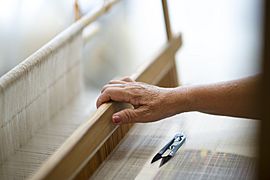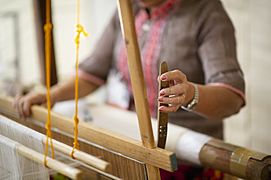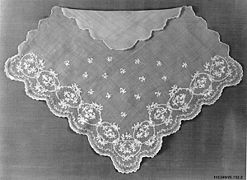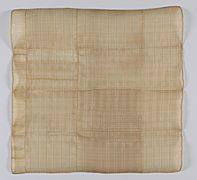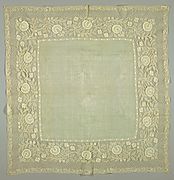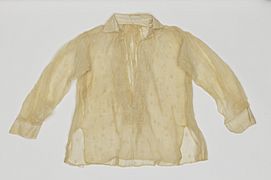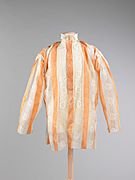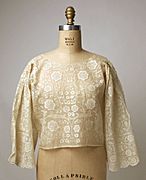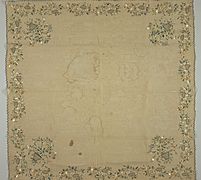Piña facts for kids
Piña (pronounced pi-NYAH) is a special fabric from the Philippines. It's made from the leaves of the pineapple plant! Pineapples first came from South America. But they have been grown a lot in the Philippines since the 1600s. People there learned to weave their leaves into shiny, lace-like fabrics. These fabrics are called nipis. The word piña comes from the Spanish word for "pineapple."
In 2018, the Philippine government started working to get Kalibo piña weaving recognized by UNESCO. This would add it to a list of important cultural traditions.
Contents
The Story of Piña Fabric
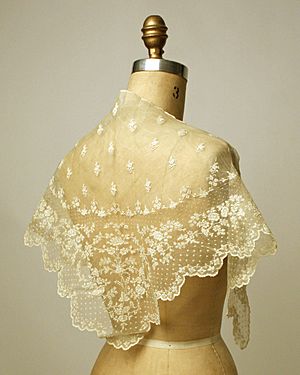
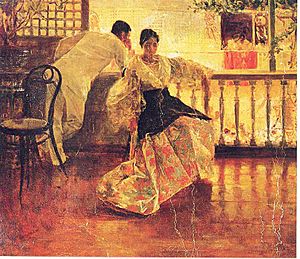
The Spanish brought pineapples to the Philippines a long time ago. This was during the time when Spain ruled the islands. By the 1600s, a type of pineapple called 'Red Spanish' was grown for its leaves. People learned to get fibers from these leaves. They used weaving skills they already had for other fibers like abacá. Piña was woven into shiny, lace-like nipis fabrics. These fabrics were often decorated with fancy embroidery.
Piña fabric became a valuable item that the Philippines exported. It was very popular with rich families in Europe in the 1700s and 1800s. Nipis fabrics were seen as unique and fancy. Even royalty used them! For example, the baptismal gown of King Alfonso XIII of Spain was made from piña. A piña handkerchief was given as a wedding gift to Princess Alexandra of Denmark. Even Queen Victoria of England had piña petticoats.
In the Philippines, piña was used for traditional clothes. These included the barong tagalog (a formal shirt for men) and the baro't saya (a traditional dress for women). Wealthy Filipinos wore these clothes. Piña was perfect for the hot weather because it was light and airy. The piña industry was badly damaged during World War II. But now, people are working to bring it back.
Pineapples were also used to make many foods in the Philippines. These include pineapple vinegar and dishes like hamonado and pininyahang manok. Another interesting product is nata de piña. This is a jelly-like dessert that has been made since the 1700s.
How Piña Fabric is Made
Making piña fabric is a careful process. First, the pineapple leaves are cut from the plant. Then, the fibers are pulled out or separated from the leaf. These fibers are long and a bit stiff. Each tiny strand of piña fiber is scraped by hand. Then, these strands are tied together, one by one. This creates a long, continuous thread. This thread is then handwoven into piña cloth.
Where Piña is Produced
Kalibo, in the province of Aklan, is the main place where piña cloth is made. It's the oldest producer in the Philippines. Piña fabric from Kalibo is sent to many parts of the world, especially North America and Europe. Piña weaving is a very old tradition. It has been brought back to life in the last 20 years.
Pineapple silk was once called the "queen of Philippine fabrics." It was the fabric chosen by the most important people in the Philippines. In 1996, world leaders met in the Philippines for the APEC summit. For their group photo, they all wore barong tagalog shirts. These shirts were made from piña fabric from Kalibo.
Some of the companies that make piña include La Herminia Piña Weaving Industry and Reycon's Piña Cloth and Industry.
What Piña Fabric is Used For
Piña fabric is known for being light and a bit stiff. It looks sheer, meaning you can see through it a little. It also has a smooth, silk-like feel. Today, it is mostly used to make traditional formal wear in the Philippines. This includes the barong tagalog and baro't saya. It's also used for things like table cloths, bags, mats, and other clothing items.
Images for kids
-
Early 19th century pañuelo in the Metropolitan Museum of Art made from piña and linen.
-
19th century cotton and piña textile in the Cooper Hewitt, Smithsonian Design Museum.
See also
 In Spanish: Piña (tela filipina) para niños
In Spanish: Piña (tela filipina) para niños


